| Type | Light cruiser | Hull | Steel |
| Displacement | 4,550 tonnes | Engines | 4 screws; 16 Schulz-Thorneycroft boilers; 25,000 hp |
| Length | 136 m | Machinery | Steam, 4 shafts |
| Beam | 14 m | Speed | 25 kts |
| Draught | 5.5 m | Complement | 432 |
| Armament | 2x150mm L/45 K, 10x105mm L/45 K, 2xTT 500mm SH | ||
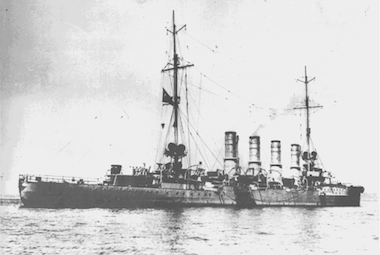
The cruiser SMS Breslau, belonging to the Magdeburg-class of the Imperial German Navy and named after a city in Lower Silesia, had its keel laid at the AG Vulcan shipyard in Stettin on 1910. She was launched on 16 May 1911 and commissioned into the German High Seas Fleet on 20 August 1912. Upon entering service, Breslau, along with the battlecruiser Goeben, was dispatched to the Mittelmeerdivision (Mediterranean Division) in response to the Balkan Wars.
As the First World War erupted, Breslau and Goeben under the command of Admiral Wilhelm Anton Souchon were assigned to disrupt French troop transports from Algeria to France. They bombarded ports in Algeria on 3 August 1914, inflicting minor damage before returning to Messina for refueling. Despite Britain not being at war with Germany, British ships shadowed the German vessels. After refueling, the ships evaded British pursuit and sailed for Istanbul, where they were transferred to the Ottoman Navy on 16 August, under the pretext of a sale. The ships were renamed, with Breslau becoming Midilli (referring to the Turkish name of the Aegean island of Lesbos), and Goeben renamed Yavuz Sultan Selim, while their German crews donned Ottoman uniforms. However, the British did not acknowledge the transfer and maintained a blockade outside the Dardanelles, prepared to attack the ships regardless of the flag they flew.
On 29 October 1914, under Souchon's command, Yavuz and Midilli as well as other Turkish ships, initiated naval warfare in the Black Sea by attacking Russian ports of Novorossiysk, Odessa, and Sevastopol. Midilli and Berk-i Satvet bombarded Novorossiysk, sinking 14 steamships, setting 40 oil tanks ablaze, and disabling the radio station. This unwarranted assault led to Russia declaring war against the Ottoman Empire on 2 November 1914, and the British Royal Navy attacking the Dardanelles on 3 November.
On 7 November 1914, Midilli shelled the port and installations at Poti, after which she began to escort Turkish convoys along the Black Sea coast in a response to Russian attacks on Turkish cargo ships. However, it was on 18 November that Midilli faced her most significant challenge yet, joining forces with the formidable Yavuz in a confrontation with Russian battleships. While Yavuz bore the brunt of the battle, sustaining damage, Midilli managed to navigate safely back to Istanbul, showing signs of the fierce encounter on its hull. In the following months, Midilli and the light cruiser Hamidiye escorted troop transports to the Caucasus. On 23 December, while alone at 4:00 AM, Midilli spotted the Russian fleet, sank a blockship, fired at a Russian battleship, and then retreated.
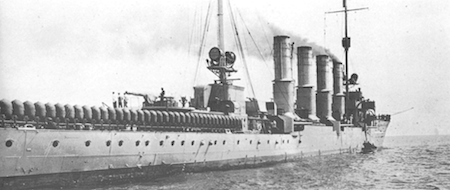
On 3 April 1915, Midilli, along with the repaired Yavuz, sailed into the Black Sea to cover the return of cruisers Hamidiye and Mecidiye, set to bombard Nikolayev. However, Mecidiye sank after hitting a mine, canceling the attack. Despite the Russian fleet sailing to intercept, Midilli and Yavuz still reached Sevastopol, sinking two freighters before retreating. Midilli created a smoke screen to draw away Russian pursuers, sinking two destroyers before fleeing. Souchon's ships reached the Bosphorus unharmed the next day.
Midilli's journey was far from over. On 10 June 1915, she engaged two Russian destroyers off Zonguldak, sustaining damage. Despite emerging victorious, Midilli's resolve was tested further on 18 July 1915 when it struck a mine near the Bosphorus while escorting a coal transport. Despite being flooded with 600 tonnes of water, the crew managed to steer the crippled vessel back to port for repairs, which lasted until the end of February 1916.
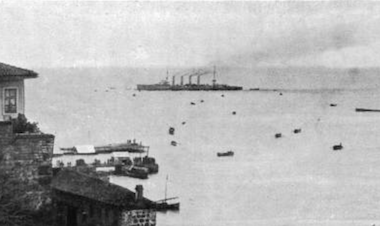
In March and April 1916, Midilli transported troops for the Caucasus front to the port of Trabzon, engaging Russian units in combat frequently. On 3-4 July, it bombarded the port facilities of Tuapse with Yavuz. However, on 21 July 1916, Midilli found itself outmaneuvered by four Russian destroyers while laying mines off Novorossiysk, forcing a retreat back to Istanbul. After undergoing basic repairs, Midilli had her remaining 10.5 cm guns replaced with 15 cm ones and an oil-fired auxiliary heating system installed due to Turkish Navy coal shortages. From April 1917 until the armistice on 25 June 1918, she conducted further operations in the Black Sea against the Russian Black Sea Fleet and secured coal transports until November 1917, including laying minefields and engaging the Russian battleship Ekaterina II.
On 20 January 1918, under the new command of German Admiral Hubert von Rebeur-Paschwitz, Yavuz and Midilli ventured out from the Dardanelles and encountered British units near the island of Imbros. They sunk the monitors M28 and Raglan, but the Turkish flotilla ran into a minefield. Midilli sank after sustaining five mine hits, while Yavuz managed to return to the Dardanelles despite being struck by three mines, eventually grounding itself there. Only 133 crew members survived from the Midilli; 330 perished.
![]()
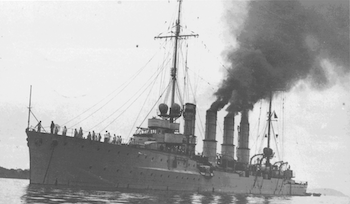
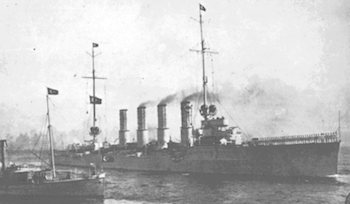
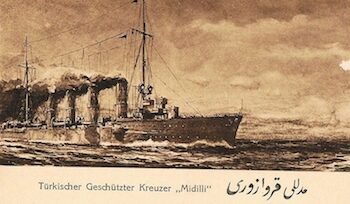
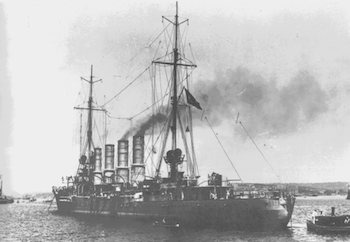
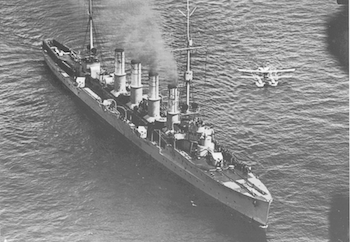
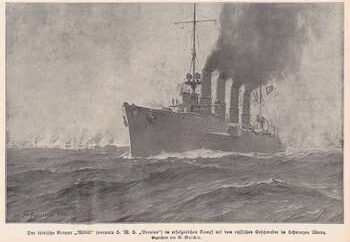
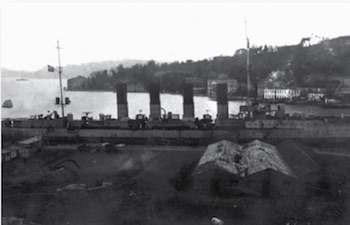
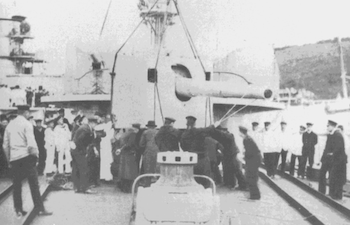
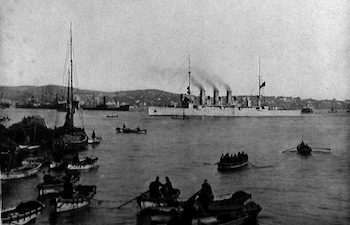
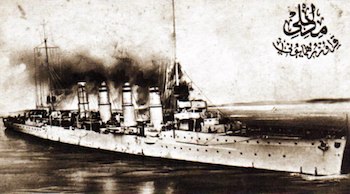
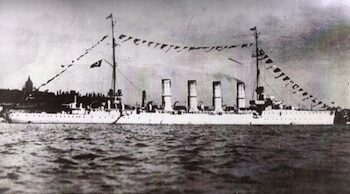
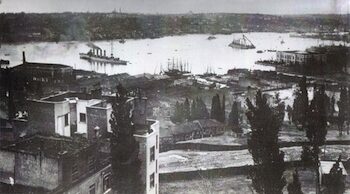
Location of the wreck of Midilli